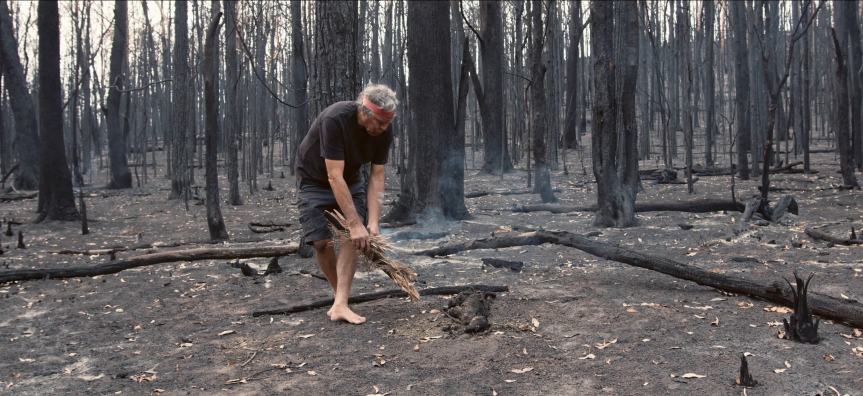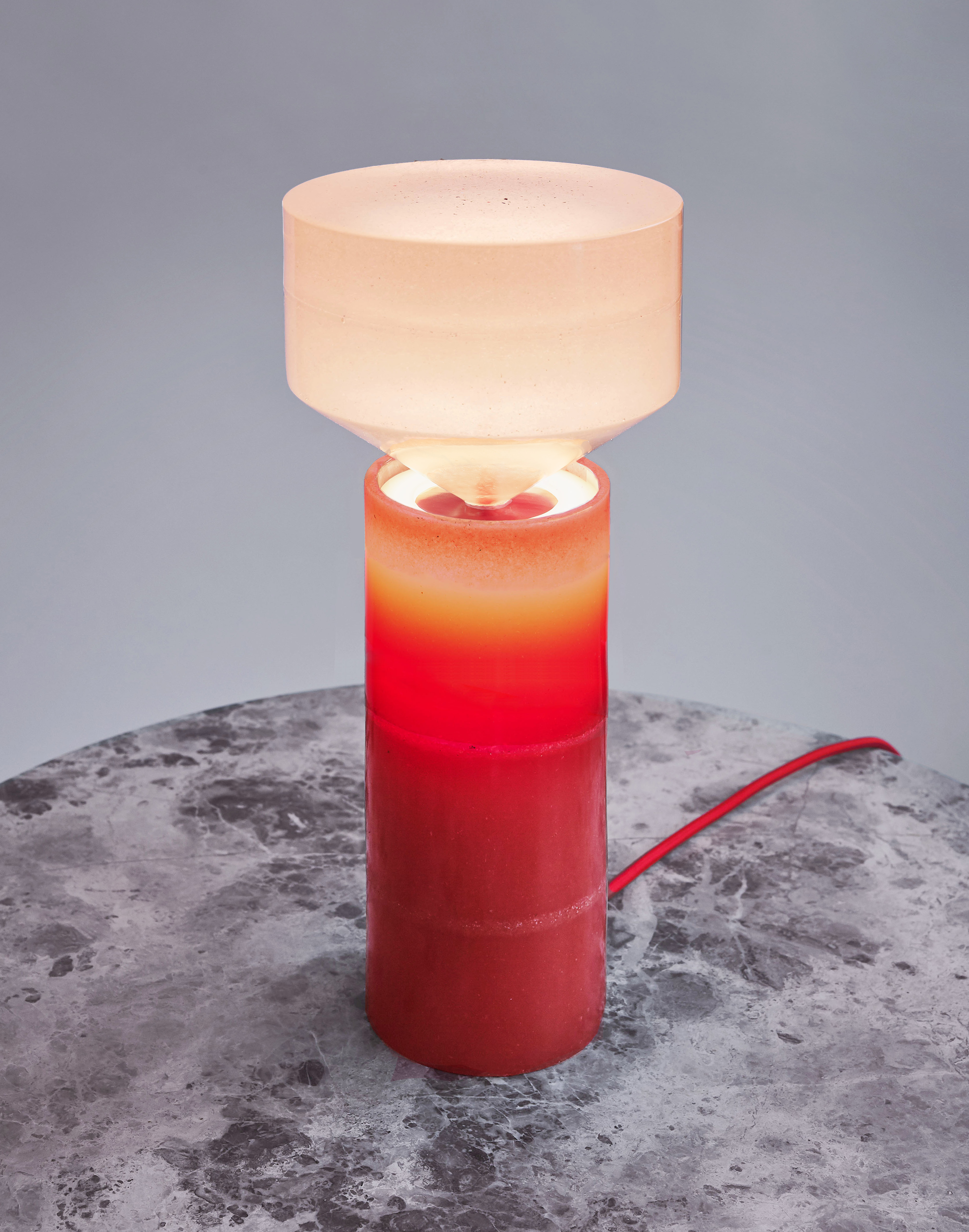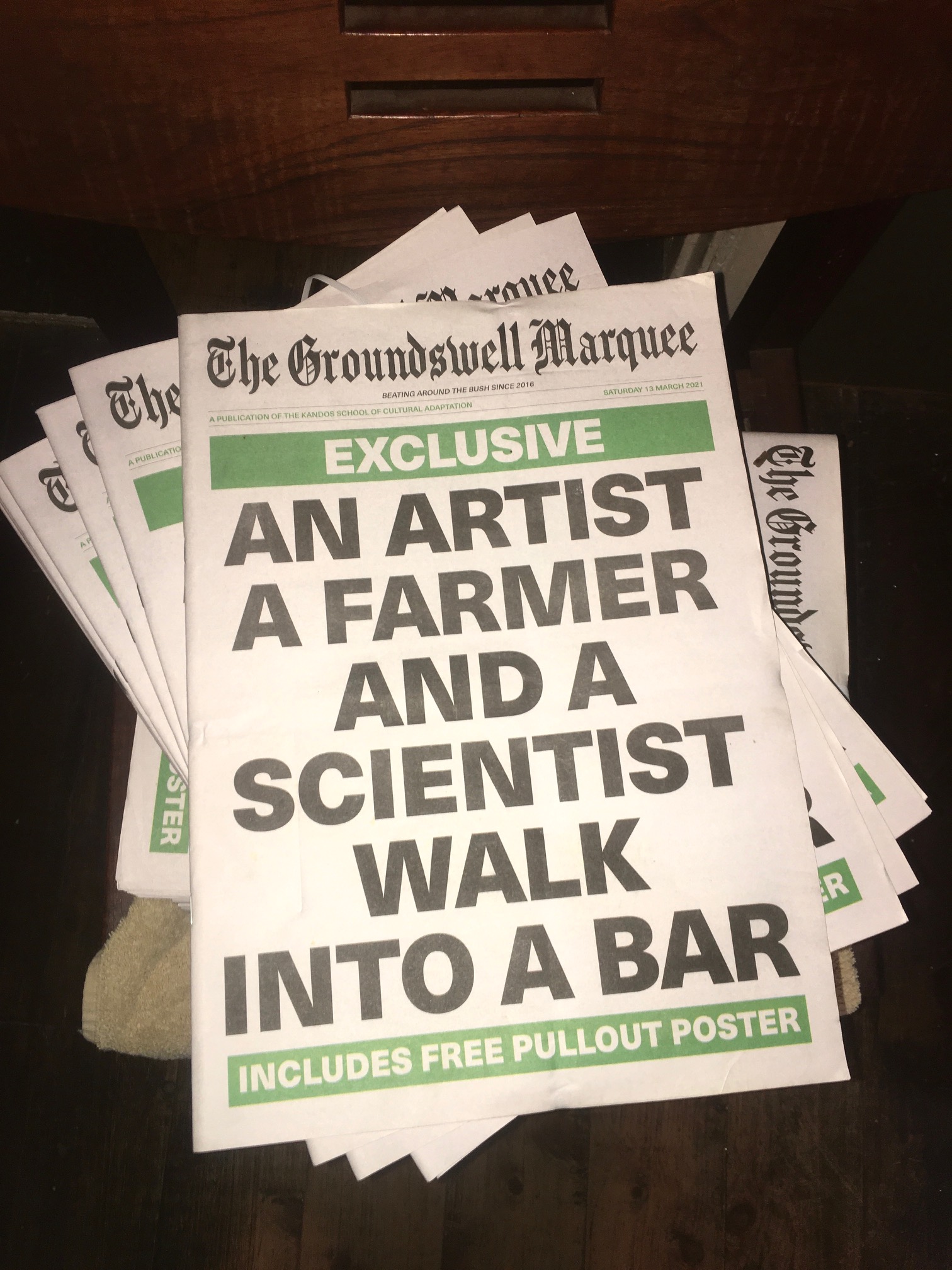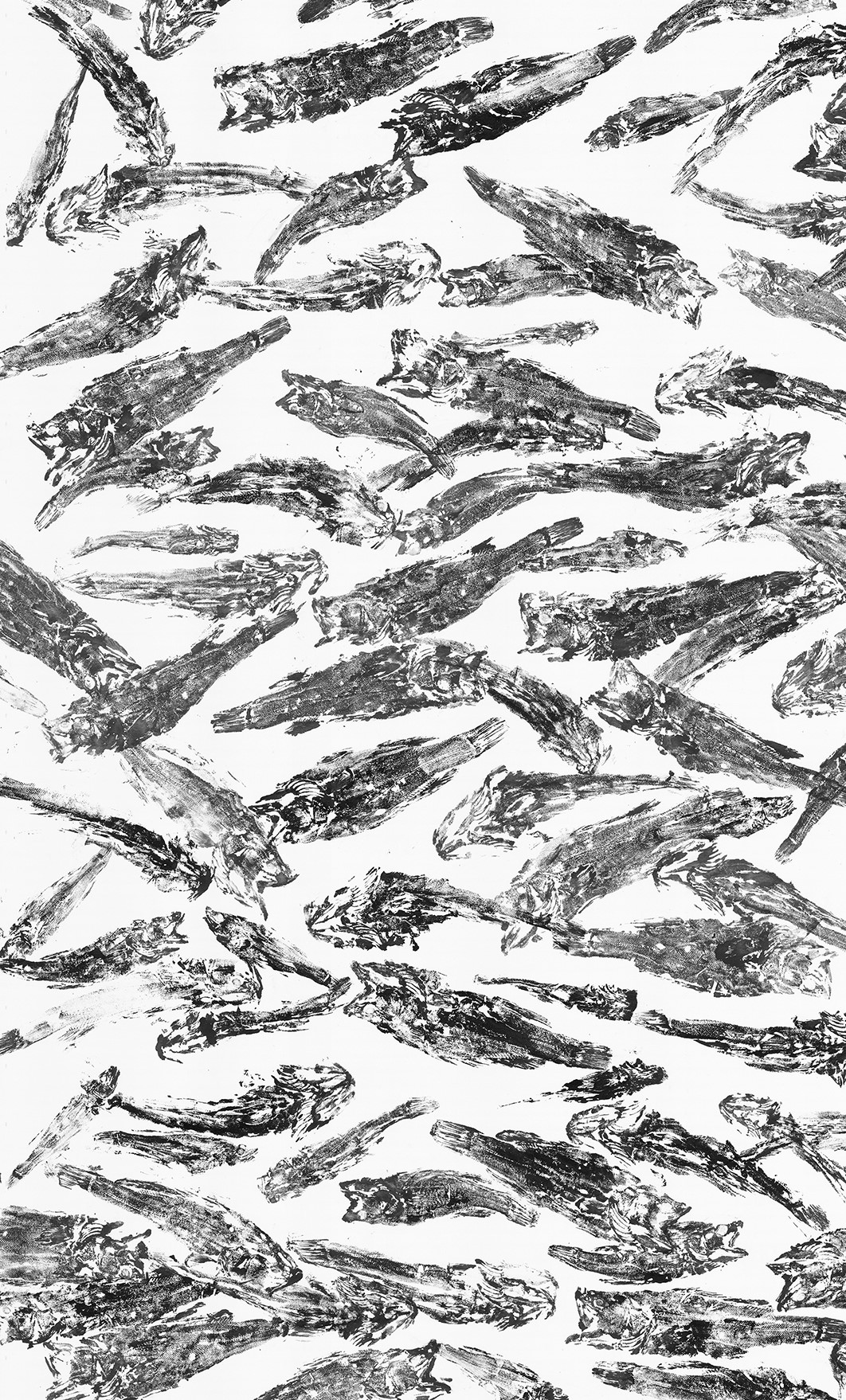
Congratulations to the winning artists and designers across the nine categories for this year’s Environmental Art & Design Prize.
These category prize winners were selected by the 2021 judging panel: Euan Macleod, artist; Lisa Cahill, CEO and Artistic Director Australian Design Centre (ADC); and Liane Rossler, artist, designer and curator.
The award-winning works give voice to the interconnectedness of humanity and the environment, provoking discussion on sustainability, creativity, and impact.
The People's Choice Awards were voted by the audience and awarded at the conclusion of the exhibition. The winners include:
2021 Winners
People’s Choice Winner - Manly Art Gallery & Museum
A J GOUGH - STOP- A sign from the Earth; Part 1
Medium - PVA, recycled timber, collected waste
Artist statement
Walking my dog along Curl Curl Beach I noticed bright fragments surfacing from the grounds of the old tip. Each day I collected a handful or two. Handfuls became bags. Bags became buckets.
I feel a deep connection to this area and I could see how the ecosystem was suffering as a result of anthropogenic influence. I started a beach clean, volunteered, talked to the people around me and avoided plastic where I could. Increasingly frustrated with the disinterest and inaction of those around me I began to express this agitation through art.
Primarily composed of single-use plastics STOP was the first piece I created using waste. I used crushed carbon from 1950s battery cells mixed with PVA glue to fill in the black details. It reached 100,000 people online and is also incorporated into an exhibit about marine plastics in the Macduff Marine Aquarium in Scotland.
Prize
$1,000 with thanks to the MAG&M Society
People’s Choice Winner - Curl Curl Creative Space
BEN GIBSON - Skatewood
Medium - old skateboards, glue
Artist statement
Trapped between the battered exterior of grip tape, ground-down graphics and skate park crud lie eight layers of beautifully pressed multi-coloured Canadian Rock Maple. With a bit of effort sanding, grinding, peeling, glueing, clamping and turning, the full majesty of the timber can be realised and an item that was destined for landfill is now a functional piece of art.
Prize
$1,000 with thanks to the MAG&M Society
People’s Choice Winner - Mona Vale Pop Up Gallery
SOPHIE SHIRRIFF - Reef's last breath
Medium - porcelain, felt
Artist statement
The world is facing a colossal climate change crisis, causing mass coral bleaching in the Great Barrier Reef. The work aims to start a conversation and remind the viewer about their own role in climate change.
The porcelain human lung represents the coral bleaching and demonstrates how our survival is dependent on the earth. The contrasting bright felt is inspired by the beautiful colours evident in a healthy coral reef and embodies a sense of hope for the future of the Great Barrier Reef.
Prize
$1,000 with thanks to the MAG&M Society
Ceramics and Small Sculpture
HELEN EARL AND BELINDA PIGGOTT - Carbon Credits
Medium - wood (from artists’ gardens), paint, aluminium, ceramic
Artist statement
The majority of the world’s scientists agree, our climate and biodiversity are being affected by human activity. The most important quest for humanity now is to find effective methods to sequester atmospheric carbon dioxide. Natural storage of CO2 occurs in vegetation. Through photosynthesis forests of trees and seaweed turn carbon dioxide into a living biomass. Today however, emissions are increasing while forests diminish. Economic incentives offer a neat solution. If more governments set a price on carbon, the market for carbon credits becomes lucrative and projects evolve.
Imagine the market protecting existing forests and incentivising reforestation - we buy time to reduce reliance on fossil fuels, and biodiversity would flourish. These spindles of leaves and kelp preserved in ceramic echo the old paper filing system of recording a sum owed (a chit) and a sum paid (receipt). The simplicity at the heart of the carbon credit system is reflected.
Prize
$5000
Judges’ comments
This work carries a strong visual message and effectively communicates the tension that exists between environmental and economic concerns. The concept, materiality and technique are harmoniously conceived and balanced. Congratulations to the collaborating artists.
Digital work, film and video
ANDREW KAINEDER - Mourning Country
Medium - video work
Artist statement
After the loss of his home and Aboriginal culture centre in the Currowan Fire, Budawang elder Noel Butler mourns not for the structures that once stood, but for the flora and fauna we share this land with.
ZAN WIMBERLEY - Coal and ice
Medium - video work
Artist statement
Using schlieren imaging for flow visualisation to manipulate light in order to visualise Co2, this two channel video work addresses the Climate Crisis by drawing a line directly between the burning of coal and the melting of glaciers and Arctic ice.
Sourcing ice from Icelandic Glaciers while on residency with Studio Olafur Eliasson in Berlin (2019), and Black Coal from a mine in Queensland (2020), Wimberley has recorded two beautiful, inverted videos: one showing Co2 falling slowly and beautifully from a chunk of glacial ice as it melts: the other showing the heat rising furiously as a lump of coal burns. Coal and Ice visualises and brings together the abstract, hyper object concept of Climate Change and its consequences.
Prize
Joint winners - $2,500 each
Judges’ comments
These two impactful video works are topical and important in their own ways and were both deserving winners in this category. The subject matters and narratives were beautifully and sensitively filmed and resolved using striking imagery which generates a powerful response in the viewers.
Functional Design
MARTA FIGUEIREDO - Stardust lamp
Medium - resin particles waste, eco-resin, powder-coated aluminium tube, fabric cord, LED strip, defusing ring and Bluetooth dimmer
Artist statement
Stardust responds to a challenge: how can I employ circular design principles to create useful things out of the waste generated by my practice? This lamp elegantly incorporates resin waste from cutting perspex. Light is dispersed through the object's body. A delicate and celestial brightness is diffused through thin particles of resin debris, adding life and depth to the eco-resin that encapsulates it. The resin waste mixed in during the pouring stages resulted in deposit lines featuring on the lamp's surface.
At the core of this luminary runs a red spine: aluminium tube, a ring and fabric cord. Stardust is not only made of waste but it can be recycled for the following iteration. Its development was thoroughly documented and published. The idea is that by using circular design principles and sharing the process, we may motivate other designers to reuse materials, perhaps causing a shift in the industry.
Prize
$5000
Judges’ comments
A beautiful, elegant and functional work which is well resolved, having considered all aspects of the design process in an ethical and socially aware manner.
Interdisciplinary Collaboration
KANDOS SCHOOL OF CULTURAL ADAPTATION - An artist, a farmer and a scientist walk into a Bar....
Medium - newspaper, 56 pages
Artist statement
KSCA is an artists' and writers' collective working together to explore the idea of adaptive cultural change. In 2018, nine artists embarked on a series of ambitious collaborations with farmers, scientists, Aboriginal knowledge-holders and rural innovators in regional NSW to explore how arts-informed collaborations can inspire fresh approaches to environmental challenges faced today.
Each of the projects had a unique focus: wild foods, solar energy, Aboriginal care for country, biochar, soil, humus, carbon sequestration and the adaptive journeys of farmers. The participants cross-pollinated knowledge and tools across their disciplines by hosting workshops, farm visits and talks, performances, and produced films, prototypes and architecture. The project seeded a new festival in Bingara NSW. It featured in an exhibition at Artbank, was the focus of talks at Carriageworks with Kaldor Public Art and culminated in this 56 page newspaper launched at the first ‘Fermenta’ Festival in Kandos NSW.
Prize
$5000
Judges’ comments
A collaborative ecosystem of science, community and innovation which has created an impressive synthesis of important environmentally focused practices – a true interdisciplinary approach, from the field to this complete document creatively realised.
Painting
SARAH ROBSON - The unfolding of reason
Medium - industrial felt, acrylic paint
Artist statement
Much of contemporary art has replaced the surprising, the inventive or a virtuosity of technique, with the overwhelmingly enormous or game-like interactivity, substituting size and physical interaction for subtlety and engaged observation. Today, more than ever, with a world plagued by over-consumption and excess I believe that modesty and focused observation are in need of restoration. Only through reasserting these qualities can we value and protect our environment.
Employing a natural material such as felt has been a way for me to maintain an art practice in the face of such enormous environmental problems. These artworks respond to changes in the atmosphere and can be rearranged, rehung and manipulated. Their provisional and organic nature highlighting our own experience of impermanence and the delicate balance of forces within the natural environment; their painted surfaces and material forms present a continuing investigation of what painting can be in the 21st Century.
Prize
$5000
Judges’ comments
This work challenges the notion of what a painting can be. It creates a strong visual impact and demonstrates a highly considered use of materials – their impact on the environment and the recyclable nature of felt. The work uses simple geometric forms and a sculptural element to evoke ideas of landscape.
Wearable Design
JOANNA FOWLES AND NINA SMITH - DYEVERT shirt
Medium - organic cotton, food waste (onion skins), cotton thread, 22 self-covered fabric buttons
Artist statement
DYEVERT shirt is a shirt that utilises food waste and zero waste pattern cutting techniques to reimagine overlooked waste materials. The DYEVERT shirt demonstrates the potential of sustainable practice within fashion and textiles by applying circular design processes. Joanna Fowles identifies waste streams transforming discarded food waste into a dye resource to colour the shirt. Each stripe on the garment is hand-painted using a traditional textile technique revealing multiple colours after dyeing the cloth in the vegetal waste.
Nina Smith applies zero waste pattern cutting techniques to minimise waste in the garment design and construction process. Both designers are responding to the systemic issues of fast fashion and the landfill of textiles. The collaboration demonstrates a less impactful garment that can be re-coloured multiple times with other food waste to reactivate the stripes. The garment can eventually return to the earth and decompose.
Prize
$5000
Judges’ comments
A garment which attains a very high level of environmental sustainability through its use of circular design process, plant dyes and waste minimisation. It is elegant, contemporary and sophisticated.
Works on Paper and Photography
SHONAH TRESCOTT - Miraculous draught of fishes
Medium - China ink on rice paper, wooden dowel
Artist statement
Inspired by the history of her great ancestors, the Wiradjuri people; Shonah Trescott spent time in the land of the three rivers with scientist Dr. Paul Humphries, a leading authority on the Murray Cod (a fish that plays a central role in Wiradjuri creation stories of the rivers). Miraculous draught of fishes seeks to evoke a meditation on place and history, exploring cultural and environmental barbarism within the landscape in a post-colonial era.
Obtaining actual Murray cod specimens from a recent mass die off event, she used the fish corpses in the traditional Gyotaku nature printing process where the specimens were inked and printed by hand. The scroll of fish corpse impressions are shown flowing down the wall and pooling in undulating folds of a seemingly endless ghostly white river, pointing to our close relationship to water, not only our most sacred connection, but also our greatest vulnerability.
Prize
$5000
Judges’ comments
The wholistic nature of this work, in concept/message and method/technique, is a fine example of the artist as powerful communicator on environmental issues. The use of simple materials belies its effectiveness to deliver an important message and reflective of community concerns.
Young artist / designer - 13 to 18 years
ROMY BEHDASHT - Compromised fragility
Medium - plastic waste, tape, paperbark, leaves, twigs, rocks, glue
Artist statement
My artwork is inspired by artist Josh Dykgraaf and by the fragility of nature and our impact on it. I have created a fragile looking sculpture of a koala, using waste, both man made (interior of recycled plastic shopping bags) and natural (exterior of paperbark, fallen leaves, twigs and rocks) to emphasize the important relation between man and nature and the importance of recycling.
Due to our actions causing global warming there is greater risk of bushfires (symbolized by the burned leaves on the sculpture). The koala's natural habitat will be compromised and in the near future koalas could become extinct. We need to compromise. Instead of trying to adapt the world to suit our needs, we should adapt our needs to suit the world. I hope my artwork will inspire people to this.
Prize
$2000
Judges’ comments
This works speaks of the dire effects of unmanaged bush fires and habitat loss on Australia’s koala population. It’s fun and clever sculptural form and use of materials belies its series environmental message.
Young artist / designer - 7 to 12 years
SELMA LUNDE STEWART - Frog
Medium - acrylic paint on canvas
Artist statement
I painted this frog as it is a beautiful animal whose existence depends upon having a clean and unpolluted environment.
Prize
$2000
Judges’ comments:
A pure and simple message is evoked through this work with an honesty and directness which speaks strongly to the environmental impacts humans have on our fragile ecosystems and creatures.
Highly Commended
Ceramics & small sculpture
- CHRYSTAL RIMMER, Banksia Vase, 650 plastic bags
- KATH FRIES, Respire i-ix, glass, dried oystermushrooms, beeswax
- SADHBHA COCKBURN, VOID, bushfire charcoal (Djiringanj land) and beeswax
Digital work, film and video
- MADELYNNE CORNISH, Muted landscape, video work
- HAYDEN FOWLER, She-Oak, video work
Interdisciplinary collaboration
- DEBBIE SYMONS, Sing, palm fronds, wire and fishing line
Painting
- BABETTE ROBERTSON, Fallen tree #8, oil on board
Works on paper & photography
- MAX VON APPEN, 2050 - A perfect summer's day at Curl Curl Lagoon, paint, miniature figures, photography
- DAMIAN DILLON, Suburban chrome #2, high resolution UV dye sublimation print on cardboard
- JASON MCDONALD, Snowy weathers, photograph printed on cotton rag
Wearable design
- IVY WHITEMAN, Why the sea is boiling hot, food waste, plant dyes and eco prints on 100% wool and line, silk fabrications
Functional Design
- MATTHEW HARKNESS, Bioplastic waste dustpan and brush, PLA (polylactic acid) waste plastic
Young artist/designer 7 - 12 years
- PHOENIX LIBOTTE, The acorn tree, pencil on paper
- ERIC YE, Dark sky, acrylic paint on canvas
Young artist/designer 13 - 18 years
- FRANCES MORAN, Cicada, acrylic paint on wood board
- SIENNA MORISON, Fake news, acrylic paint on canvas, triptych












